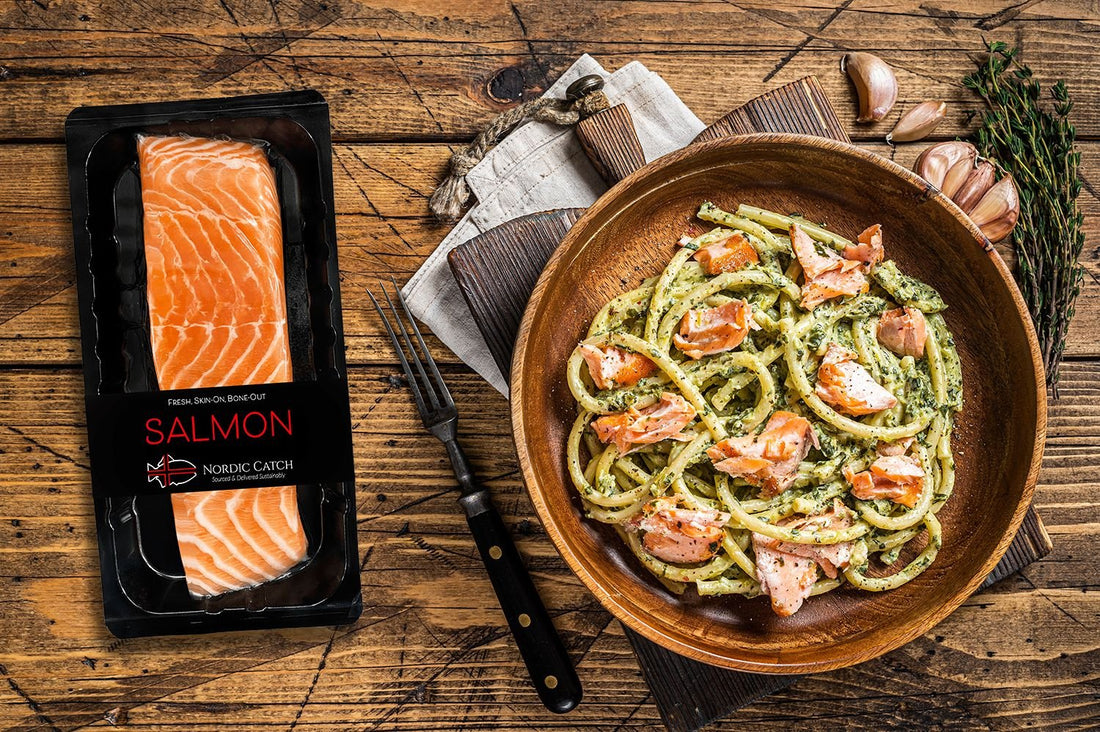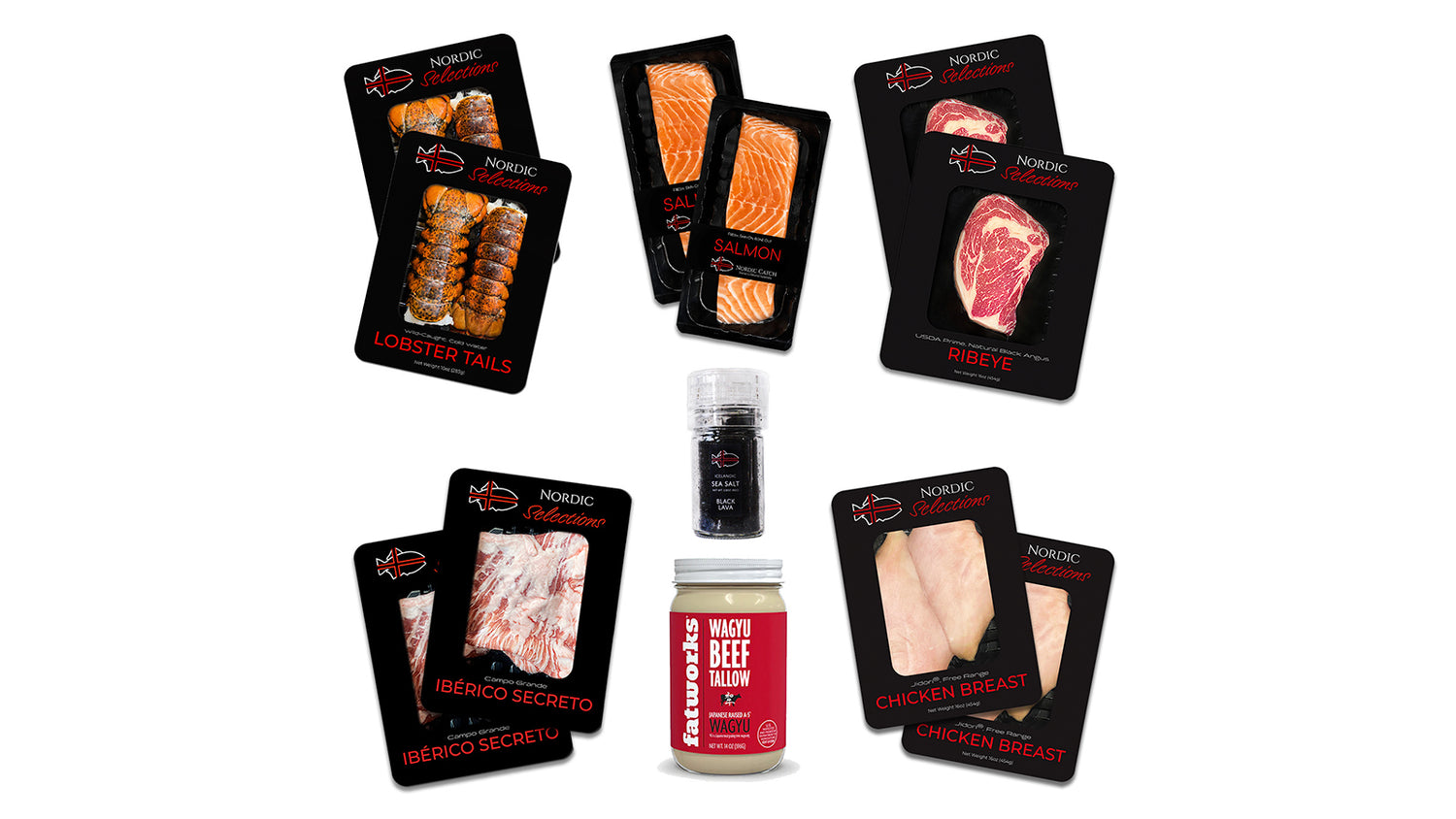
7 Best Seafoods for Weight Loss
Combining smart seafood choices with regular exercise and a healthy diet can help you achieve sustainable weight loss.
But some kinds of seafood are better than others for weight loss — vital information to remember as you browse your local grocery store for the best weight loss, shop around for a fish delivery service, or save dozens of Instagram and TikTok recipes. Here are several species to keep in mind.
The Best Seafood for Weight Loss
Salmon
Salmon is one of the healthiest types of seafood and generally one of the easiest to prepare. And if you're not the biggest fan of seafood, salmon is one of the least "fishy" types, making it a good one to start with!
Sushi-grade salmon is delicious and packed with omega-3 fatty acids and protein. Salmon is one of the highest-protein seafood. A 100-gram serving contains 11 grams of healthy fat and 23 grams of protein — a near-perfect ratio for weight loss and muscle preservation. With salmon having only 156 calories per serving, you can still load up your plate with fruits and vegetables to reach satiety earlier, keeping you fuller for longer while consuming tons of essential nutrients. Learn the best ways to cook salmon to add to its taste, texture, and nutritional value.
Some salmon is better than others, particularly North Atlantic salmon, so check the labels as you shop around. And as with most seafood, fresh fish is better than frozen fish.
Tuna
Tuna, one of the most popular seafoods in America, is another protein-rich seafood that contains omega-3s, Vitamin D, and selenium. It also features a high taurine content, which helps regulate blood pressure. On average, a 3-ounce can of light tuna in water contains approximately 70-100 calories, with about 16-20 grams of protein, 0.8-2.5 grams of fat, and virtually no carbohydrates.
A 100-gram serving of Ahi tuna steak contains 106 calories, nearly 25 grams of protein, less than 1 gram of fat, and 0 grams of carbohydrates.
Keep in mind, however, that tuna is notably higher in potential mercury content than other types of seafood, so if you plan to eat it regularly, choose smaller species like chunk light tuna instead of yellowfin and albacore. You can consume these safely, just in moderation. This is especially the case for children and pregnant women.
Cod
Cod is a white fish that's extremely low in calories but high in protein. It's also easy to cook even if you've never cooked seafood. A 3-ounce (85-gram) serving of cooked wild Icelandic cod contains approximately 90 calories, 19 grams of protein, and less than 1 gram of fat. Pacific cod is similar, with about 85 calories, 20 grams of protein, and less than 1 gram of fat per serving.
Cod is virtually carbohydrate-free, making it ideal for low-carb diets. It's also rich in essential vitamins and minerals, including vitamin B12, phosphorus, and selenium. Cod's high protein content helps increase satiety and preserve lean muscle mass during calorie restriction.
While cod has a slightly lower omega-3 content than fatty fish like salmon, it still supports weight loss and heart and brain health. Cod is generally the type of fish cooks use in fish and chips, but if you're trying to lose weight, you should refrain from frying it as you would in that dish. Instead, opt for grilling, baking, or steaming it to keep it as low-calorie as possible.
Sardines
While not the most flavorful fish, sardines are great for weight loss. A 3-ounce serving of canned sardines in oil contains approximately 191 calories, 22.6 grams of protein, and 10.5 grams of fat, with no carbohydrates. They're also rich in omega-3 fatty acids, which can help reduce inflammation and support heart health.
Sardines also contain essential nutrients like calcium, iron, and vitamin D. Their protein content helps increase satiety and preserve lean muscle mass during a calorie deficit. The omega-3s in sardines may aid in weight management by suppressing appetite and reducing inflammation.
Aside from weight management, sardines have been linked to improved cholesterol levels, brain health, and skin health. Compared to larger fish, they're also low in mercury.
Mackerel
A 3-ounce (85-gram) serving of cooked Atlantic mackerel contains approximately 223 calories, 21 grams of protein, and 15 grams of fat. The majority of the fat in mackerel is heart-healthy omega-3 fatty acids, with over 2,000 mg per serving.
Mackerel is rich in vitamins and minerals, particularly vitamin D, B12, and selenium. Its high protein content helps increase satiety and preserve lean muscle mass during calorie restriction.
If you're trying to lose a few pounds, opt for Atlantic or Pacific chub mackerel, as these are lower in mercury than king mackerel.
Grilling, baking, or pan-searing are healthy preparation methods that maintain mackerel's nutritional benefits without adding tons of calories.
Shrimp
A 3-ounce (85-gram) serving of cooked shrimp contains approximately 84 calories, 18 grams of protein, and less than 1 gram each of fat and carbohydrates. This makes shrimp a nutrient-dense food that can help you feel full while keeping your calorie intake low.
Shrimp is also rich in essential vitamins and minerals, including selenium, vitamin B12, and phosphorus. It contains omega-3 fatty acids, which can potentially suppress appetite and reduce inflammation.
To keep the calorie count low, grill, bake, or steam shrimp without breading or using calorie-heavy oils. Be mindful of portion sizes, too, because it's pretty easy to overeat shrimp. While this seafood is generally low in mercury, those with shellfish allergies should avoid shrimp. Refer to our shrimp sizing guide to ensure you select the correct size for your dish, as more giant shrimp may result in larger servings.
Halibut
A 3-ounce (85-gram) serving of cooked halibut contains approximately 94 calories, 19 grams of protein, and less than 2 grams of fat. It's virtually carbohydrate-free, making it ideal for low-carb diets.
Wild halibut is rich in essential vitamins and minerals, including selenium, niacin, phosphorus, magnesium, and vitamins B12 and B6. Its high protein content helps increase satiety and preserve lean muscle mass during calorie restriction.
Regular consumption of halibut has been linked to improved heart health, brain function, and bone strength. To keep it low in calories, grill, bake, or steam it rather than frying it.
These are the best seafood for weight loss with an optimal calorie-to-protein ratio. But many of these fish offer other nutritional benefits beyond weight loss, all contributing to a healthier lifestyle. For more information on shopping for seafood, check out our Seafood Buying Guide.
How to Cook Seafood to Lose Weight
Meal Planning Tips
When meal planning for weight loss with seafood, choose lean options like cod, halibut, and tuna, which are high in protein and low in calories. Aim to include fish in your diet at least twice a week, as the American Heart Association recommends.
Plan meals that combine seafood with plenty of vegetables and whole grains for added fiber and satiety. Use cooking methods like grilling, baking, or steaming to keep calorie content low, and avoid frying, using calorie-intensive oils, or breading. These can quickly add up to 100 to 200-plus calories per meal.
Choose a variety of seafood to ensure a broad spectrum of nutrients. Regarding farm-raised versus wild-caught seafood, wild-caught tends to have fewer contaminants and more nutrients than farmed seafood like farmed-raised salmon. Supplements like fish oil can provide additional omega-3s in your diet if necessary.
Healthy Cooking Methods
How you cook seafood matters. Grill, bake or steam it to retain nutritional value without adding unnecessary calories.
- Grilling: Lock in flavor while reducing fat. This method is ideal for salmon or shrimp.
- Baking: Wrap fish in parchment paper with spices to retain moisture without adding fats.
- Steaming: This method preserves nutrients and works well for delicate seafood like shrimp and tilapia.
Risks and Considerations
Large fish like tuna may contain high levels of mercury, which can pose health risks, particularly for children and pregnant women. To limit exposure, add smaller fish like sardines or shrimp to every other meal.
Learn how to tell if your seafood is fresh to avoid spoiled ingredients. Be cautious of seafood allergies, which can range from mild reactions to severe anaphylaxis. Consult a healthcare provider if you're uncertain about possible sensitivities before adding seafood to your diet.
Choose seafood certified by the Marine Stewardship Council (MSC) or other sustainable organizations to ensure your consumption supports environmentally friendly practices. Sustainable fishing practices are crucial for preserving marine ecosystems.
Frequently Asked Questions
What are the benefits of eating seafood for weight loss?
Seafood is high in protein and low in calories, making it great for fat loss, boosting metabolism, and increasing satiety.
Which is better: wild-caught or farm-raised seafood?
Wild-caught seafood generally has a more nuanced flavor (due to their varied diet) and fewer contaminants. In contrast, farm-raised has a milder, buttery flavor and may have more contaminants.
How does the sustainability of seafood sources matter?
Both wild-caught and farm-raised seafood have ecological implications: Overfishing can deplete wild fish populations, while fish farming can lead to water pollution and habitat destruction. Responsible sourcing is crucial since sustainable seafood preserves marine life and supports responsible fishing practices.
What precautions should you take regarding seafood allergies?
Check labels and ask about the food's preparation. Severe allergies require immediate medical attention. Symptoms can range from mild (hives, itching) to severe (anaphylaxis). Seek immediate medical help if you experience any severe symptoms after consuming seafood.

